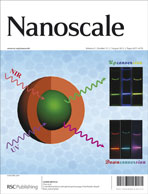Perylenediimide functionalized bridged-siloxane nanoparticles for bulk heterojunction organic photovoltaics†
Abstract
Perylenediimide functionalized bridged siloxane nanoparticles were prepared by direct hydrolysis and condensation of a perylenediimide silane precursor in the presence of a catalytic amount of tetraethoxysilane (TEOS). The sizes of the particles were controlled by adjusting organotrialkoxysilane, base, and TEOS concentrations. Using this modified Stöber method, we were able to incorporate a higher load of organic content (∼70%) into the siloxane core compared to typical organically modified Stöber silica nanoparticles. The size, shape, and surface morphology of these functionalized particles were visualized using transmission electron microscopy. Their compositions were confirmed by FTIR, thermogravimetric analysis, and elemental analysis. The photovoltaic performance of these nanohybrids in the poly(3-hexylthiophene) polymer matrix was evaluated. The device made from a sample annealed at 150 °C showed reasonably good photovoltaic performance with a power conversion efficiency of 1.56% under standard test conditions of AM 1.5G spectra at an illumination intensity of 100 mW cm−2.


 Please wait while we load your content...
Please wait while we load your content...